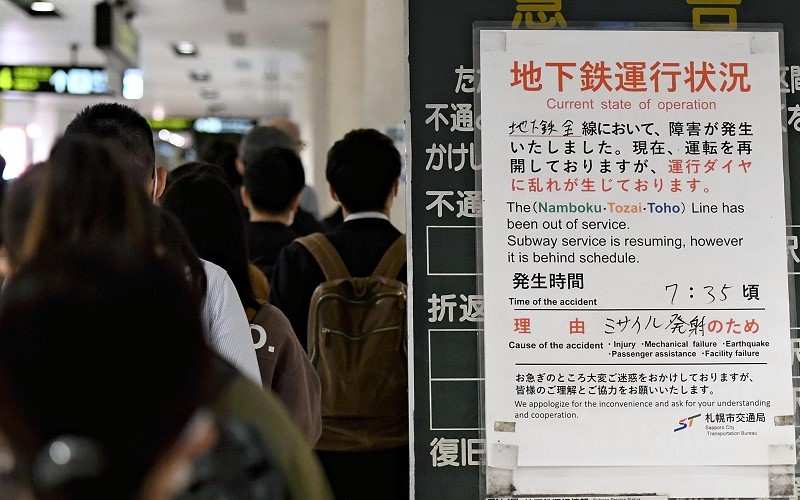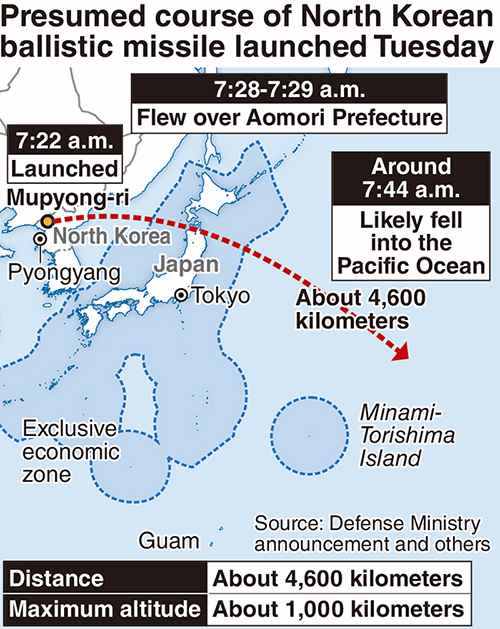N. Korean ballistic missile flies over Japan for 1st time since 2017

A sign at Odori Station in Sapporo says operations are behind schedule because of a missile launch on Tuesday morning.
17:20 JST, October 4, 2022

Without warning, North Korea launched a ballistic missile on Tuesday morning that flew over Japan and into the Pacific Ocean.
This marked the seventh time that the path of a North Korean missile has taken it over Japan, and the first since Sept. 15, 2017, when an intermediate-range Hwasong-12 ballistic missile flew over Hokkaido.
The Defense Ministry said the missile was launched around 7:22 a.m. and had a maximum altitude of about 1,000 kilometers, before falling into the Pacific Ocean outside Japan’s exclusive economic zone at 7:44 a.m. about 3,200 kilometers east of Kamaishi, Iwate Prefecture. No damage to aircraft or ships has been confirmed.
The total distance of about 4,600 kilometers from the launch site to the point the projectile fell into the ocean is thought to be the longest ever recorded for a North Korean ballistic missile.
According to the South Korean military, the launch site was near Mupyong-ri in the northern province of Jagang, and the missile reached Mach 17.
Immediately after the launch, the Japanese government raised the J-Alert warning calling for people in applicable areas to shelter and used the Em-Net emergency information network to contact municipalities. The Self-Defense Forces did not engage in any interception procedures, judging that there was no danger of the missile falling in Japan.
The missile is believed to have passed over Aomori Prefecture at 7:28-7:29 a.m.
“It is believed to have been a ballistic missile with a range of an intermediate-range ballistic missile or longer,” Defense Minister Yasukazu Hamada said to reporters.
North Korea also launched a Hwasong-12 from Mupyong-ri in January. Japan is analyzing the possibility that it may have been the same type of missile this time as well. The Hwasong-12 has an estimated range of about 5,000 kilometers, said to be capable of reaching the U.S. territory of Guam.
“I strongly condemn this outrage following the recent repeated launch of ballistic missiles,” Prime Minister Fumio Kishida said to reporters at the Prime Minister’s Office.
This is the 23rd time this year that North Korea has launched missiles including cruise missiles. Since Sept. 25, North Korea has conducted five launches, firing off eight missiles.
In late September, Washington and Seoul conducted joint naval exercises in waters off South Korea with the presence of the USS Ronald Reagan nuclear-powered aircraft carrier to enhance deterrence against Pyongyang. At the end of the same month, Japan, the U.S. and South Korea also conducted a joint anti-submarine drill. In response, North Korea has been displaying a confrontational posture, with the latest missile launch believed to be aimed at strongly checking the three nations.
On Tuesday morning, Kishida held the four-minister — prime minister, chief cabinet secretary, foreign minister and defense minister — meeting of the National Security Council to discuss the response. The prime minister also instructed government officials to assess any damage, gather and analyze information thoroughly, and cooperate with relevant nations. The government, through its diplomatic channels in Beijing, lodged a stern protest with North Korea.
“This is a serious and imminent threat to the security of our country,” Chief Cabinet Secretary Hirokazu Matsuno said during an emergency press conference just after the missile launch. “It threatens the peace and security of the region and the international community.”




